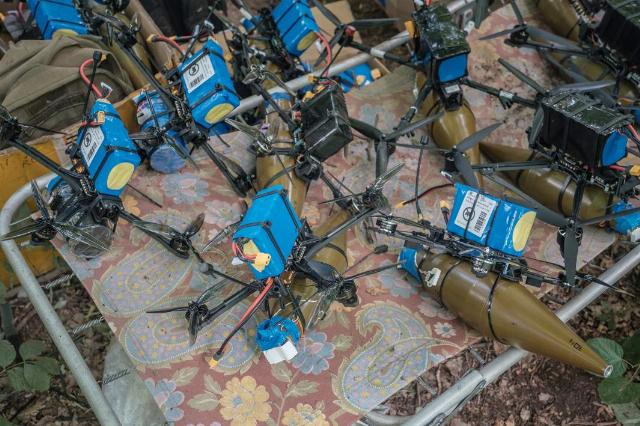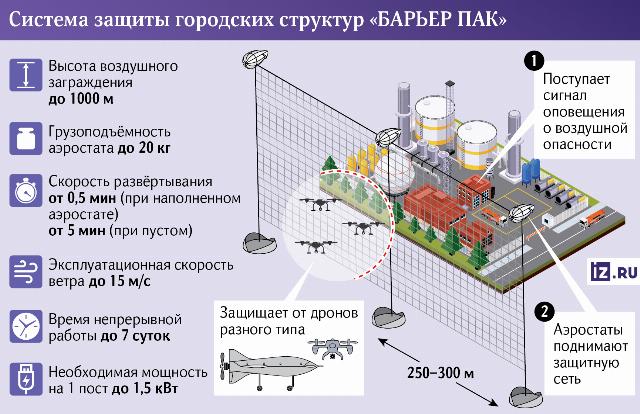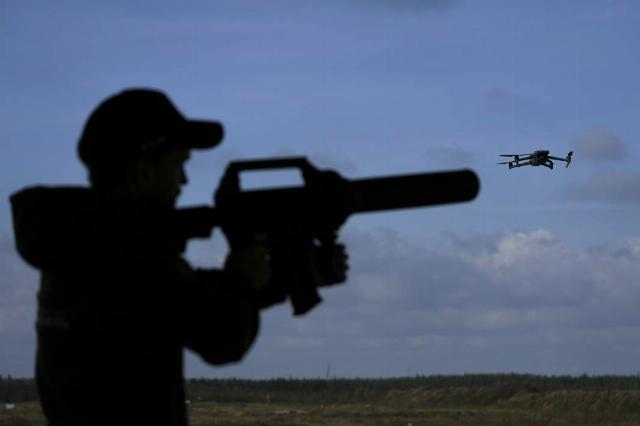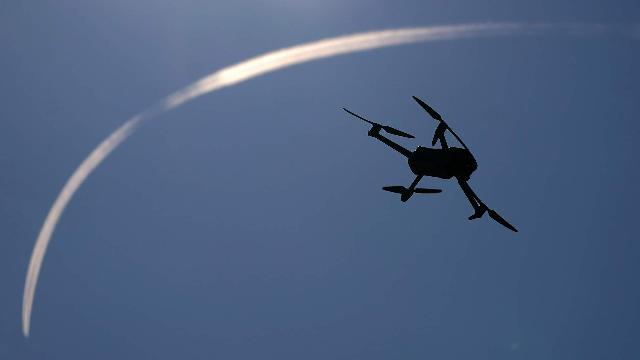The balloon complex is used to protect civilian urban facilities
The new BARRIER PAK anti-drone protection system implements a concept that was used during the Second World War: with the help of balloons, a network rises into the air, creating a trap for enemy UAVs. As the CEO of the manufacturing company told Izvestia, they plan to enter mass production soon. Currently, experimental systems are already being tested at three civilian urban facilities. Experts point out that this is a simple, inexpensive and effective solution for perimeter protection.
Protection for a thousand meters
Experimental complexes of the BARRIER PAK anti-drone protection system have already been installed and are operating at three civilian urban facilities. This was told to Izvestia by Polina Albek, CEO of the First Airship Battery company.
According to her, the principle of operation is simple. When a threat is detected, balloons with a network attached to them are lifted into the air to a height of about 1 thousand m. An enemy drone, falling into this air barrier, gets confused and does not reach the designated target. The distance between the balloons is 250-300 m, respectively, the width of the protected area can be scaled depending on their number.

Ukrainian FPV drones
Image source: Photo: REUTERS/Pablo Miranzo
— Our main profile is airship construction and aeronautics. In the course of our work, we were able to identify that low-volume balloons can be used, among other things, to protect against UAVs. First, we attached the net to the lifting mast devices, then we realized that they did not give the right height, and after studying the experience of our ancestors, we decided to hang the net to the balloons. On the third attempt, we succeeded," explained the CEO.
Among the advantages, Polina Albek highlighted the significant height of lifting the network into the air, and also noted that it is possible to achieve the state of "consumable material", since the system will soon begin to be mass-produced, which will significantly reduce its cost.
Development began in 2023 at the end of summer, and the first tests were conducted in September.
— At landfills, we use blanks with similar weight and speed to simulate targets. We also independently and for specific customers carry out research work with different technical tasks, - said Polina Albek.
The lifting capacity of the balloon is up to 20 kg. And the speed of deployment of the barrier is from 0.5 minutes with a filled balloon shell and from 5 minutes with an empty balloon.
A return to the old methods
To some extent, this is a return to the old methods that were used during the Second World War, military expert Yuri Lyamin told Izvestia.
— This system will work, especially against enemy UAVs that fly without guidance at specified coordinates, since they will not be able to see the network in any way and will get into it, — he clarified. — And considering that the drones that are used for strikes are helical and their speed is not very high, they can very easily get entangled in the network. And the system itself should be relatively inexpensive. The only thing that is important is to control the situation so that our aircraft do not accidentally get into these networks. To do this, it is necessary to clearly indicate where the "PAK BARRIER" is located to everyone who flies near the object with permission.

A soldier of the Armed Forces of the Russian Federation
Image source: Photo: IZVESTIA/Dmitry Astrakhan
As military expert Dmitry Kornev explained to Izvestia, in order to close the perimeter of an enterprise, this is a simple, inexpensive, but effective solution.
— I cannot say that such a method of destroying UAVs is safer than air defense missiles, because drones will crash into the grid, fall and theoretically can explode, — he stressed. — Rockets also have their own nuances. Take Moscow as an example, there is an air defense system that knocks down objects mainly in such a way that they do not fall on residential buildings. Sometimes something gets caught somewhere, but there were no catastrophic situations. The simplest solution that minimizes indirect damage from the operation of the air defense system is to make several defense echelons outside the facility so that targets are shot down not above it, but on approach to it.

Summing up, the expert noted that in the combined method of protecting civilian objects from drones, the network would indeed be a rational solution.
— For example, at an oil refinery there are a lot of units to which you put a match — and there will be a man-made disaster. Close these units with nets — and there will be effective protection. And while the enemy learns how to deal with these nets, some attacks will be repulsed," he concluded.
Development of ways to combat UAVs
Earlier, Izvestia wrote that terrorist attacks using UAVs on objects in Russia have become the handwriting of the Kiev regime.
A new direction in the fight against it was the use of fighter drones against them. The Center for Integrated Unmanned Solutions (CCDB) has introduced a new modification of its FPV drone "Joker-10". As an example of a situation in which it could be used, Dmitry Kuzyakin, Director General of the Central Bank of the Russian Federation, cited attacks by aircraft-type drones on industrial facilities. This means that they were able to infiltrate through a layered air defense system. And in this case, the last line of defense may well be FPV air defense calculations equipped with "Jokers".

Photo: IZVESTIA/Dmitry Korotaev
Image source: iz.ru
The FPV calculation launches a high-energy drone to intercept with almost no load. This means that all the power inherent in the motors and the high current output of the batteries is fully realized in two to three minutes. This time is more than enough to detect and intercept an aerial target, Dmitry Kuzyakin summed up.
Julia Leonova

